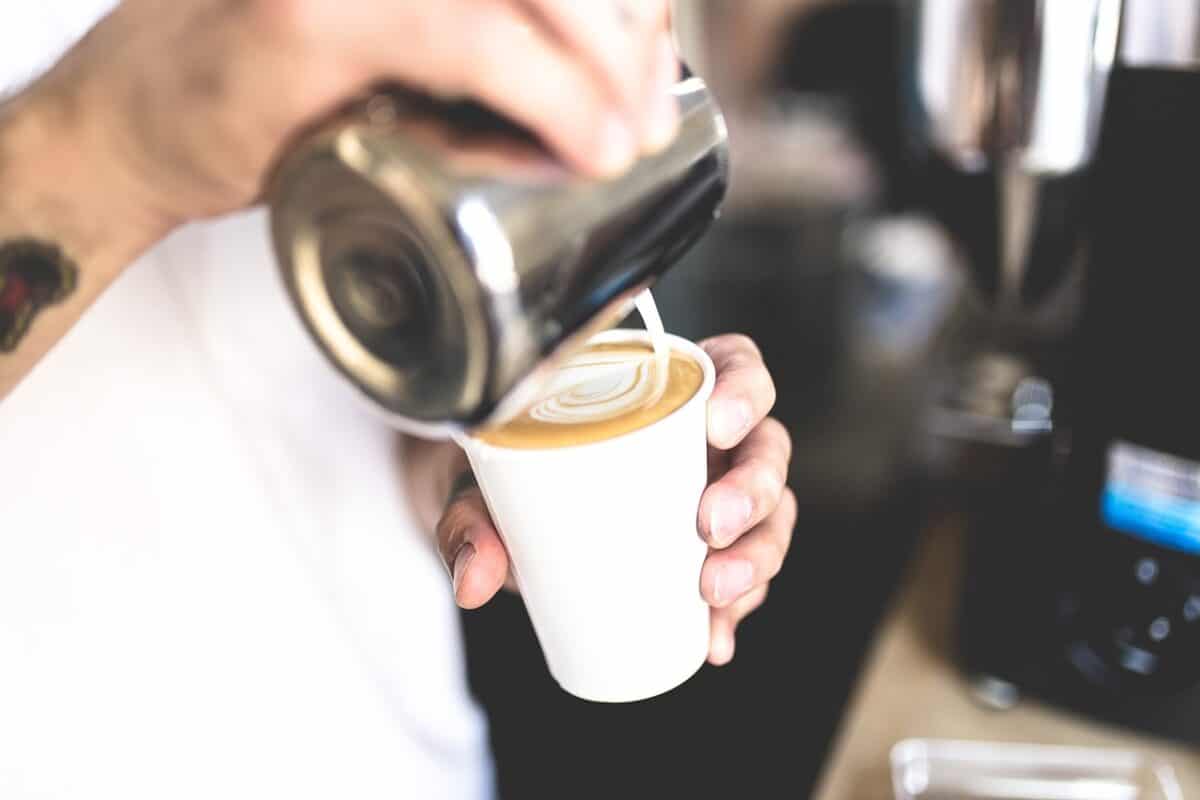When I first started brewing my coffee, I experienced drinking a watery latte several times. This resulted in a bland taste that ruined my morning coffee. I will explain why your latte is watery and give tips to improve your coffee game.
Contents
Why Is My Latte Watery?
Too much milk, under-extraction, wrong grind size, and improper tamping are why a latte can turn out watery. A higher milk ratio can dilute the espresso and weaken your latte taste. Meanwhile, a too-coarse grind and low water temperature can produce bitter and more saturated coffee.

A watery latte can only waste your coffee. It’s essential to invest in the right ingredients and equipment, as well as learn proper brewing and steaming techniques. Whether you prefer a classic vanilla latte or a bold espresso macchiato, a little practice and patience can help you become a latte-making pro.
What Are the Factors That Make a Watery Latte?
If you’re struggling with a watery cup of latte, you must first understand the factors that influence the consistency of lattes.
| Reason | Solution |
| Milk-to-Espresso Ratio | Try one-third espresso to two-thirds milk |
| Milk Temperature | Use milk with a temperature ranging from 140 and 160 degrees Fahrenheit |
| Milk Type | Opt for whole milk |
| Extraction | Avoid under-extraction |
| Brewing Time | Keep brewing time between 20 to 30 seconds |
| Grind Size | Use medium-fine grind size |
| Tamping Pressure | Compress the coffee puck with about 20-30 pounds of pressure |
| Espresso Machine | Make sure your espresso machine is working properly |
Influence of Milk
There are different reasons why milk causes you to end up with a watered-down latte that tastes weak.
Milk-to-Espresso Ratio
Finding the right balance can take some practice. However, a good rule of thumb is to use about two ounces of espresso and six ounces of milk for a 12-ounce latte.
During my first few tries, I found that too much milk in the latte would make it watery and lack flavor. On the other hand, if there is too much espresso, the latte will be too strong and bitter. Eventually, the ratio that worked for me was one-third espresso to two-thirds milk.
Too Cold Milk Temperature
The temperature of the milk is also vital in determining the consistency of a latte. The ideal temperature for milk is between 140 and 160 degrees Fahrenheit.
If the milk is too hot, it can scorch the espresso, resulting in a bitter taste. If the milk is too cold, it can cause the latte to be watery.

Low-Fat Milk
The quality of the milk used can also affect the consistency of a latte. There was a time when I usually used low-fat milk in coffee to control dairy intake. This made my latte thin and watery.
However, this doesn’t necessarily mean you need to switch to milk with high-fat content, as this can make the latte too heavy. The ideal milk for a latte is whole milk or 2% milk.
Espresso Extraction
How you create the espresso also plays a significant role in why you’re producing a weakly-flavored espresso.
Under-Extraction
Under-extraction is a common problem that can result in a watery latte. This occurs when the espresso needs to be extracted more, and the water passes through the coffee too quickly.
To avoid this, use freshly ground coffee beans and tamp the espresso with enough pressure.
Incorrect Brewing Time
The brewing time can also affect the consistency of a latte. If the espresso is brewed too long, your latte can become bitter and over-extracted.
If brewed for a short time, it can be solid and watery. The ideal brewing time is between 20 and 30 seconds.
Too Coarse Grind Size
The coffee grind size can also affect a latte’s consistency. Back then, I usually used any grind size to brew coffee.
After several tries, a medium-fine grind size helped me avoid a watery latte. This size slows the extraction process, producing a more concentrated espresso shot.
If the grind is too fine, it can cause the espresso to be over-extracted and bitter. Meanwhile, if the grind is too coarse, it can prevent the espresso from being weak and watery. This is why having a coffee grinder is crucial, especially if you’re using an Aeropress.

Inconsistent Tamping Pressure
Tamping pressure is also significant in determining the consistency of a latte. If you don’t distribute the grounds equally, the coffee bed will become denser, allowing water to flow quickly.
If the puck is tamped with enough pressure, it can prevent the water from passing through too quickly, resulting in a weak and watery latte. In contrast, if it is tamped with too much pressure, it can cause the espresso to be over-extracted and bitter.
I compress the coffee puck with about 20-30 pounds of pressure for the best result.
Broken Espresso Machine
Finally, a broken espresso machine can also result in a watery latte. If the machine is not functioning correctly, it can cause the espresso to be under-extracted and weak. If you notice any problems with your espresso machine, have it serviced immediately.
Sometimes, a French press or drip coffee may not evenly distribute water over the grounds. As a result, some of the coffee grounds may become under-extracted if the water isn’t evenly distributed.
How Do You Make a Latte Less Watery?
I understand the frustration of a watery latte and a coffee that tastes bad. Luckily, several ways exist to fix this issue and create a delicious, creamy latte. Here are some tips.
- Adjust the espresso shot: If your latte is too watery, it may be because your espresso shot is not strong enough. Adjust the amount of coffee and water you use when pulling the shot. A standard espresso shot is one to two ounces of coffee extracted from the beans.
- Froth the milk correctly: The milk is a crucial component of a latte; if it’s not frothed correctly, it can make the drink watery. Make sure to use cold milk and a clean frothing pitcher. Once the milk starts to froth, move the pitcher down to create a whirlpool effect.
- Use suitable milk: Whole milk is the best option for creating a creamy, rich latte. However, try oat or almond milk if you want a dairy-free alternative. These kinds of milk have a natural sweetness that pairs well with espresso.
Preparing espresso at home can be frustrating at first, causing you to make some mistakes. By following these tips, you can create a delicious, creamy latte that’s not watery. Remember to experiment and find the perfect coffee, milk, and froth balance for your taste preferences.
Related Questions
Why Is My Espresso Thin?
The most common reason for thin espresso is under-extraction, which means the water did not extract enough coffee from the grounds. Several factors, including a low brewing temperature, a coarse grind, or too little coffee, can influence this.
How Do You Thicken A Latte?
To thicken a latte, you can add more steamed milk or foam. This can be achieved by increasing the amount of milk used or adjusting the steaming technique. Alternatively, you can use a milk alternative that naturally has a thicker consistency, such as coconut milk or oat milk.
What Makes A Latte Creamy?
A latte becomes creamy primarily due to the addition of steamed milk. Steaming introduces air into the milk, creating a velvety texture and incorporating tiny bubbles. The combination of espresso and the microfoam from steamed milk contributes to a latte’s rich, creamy mouthfeel.
Conclusion
It’s important to remember that the quality of your latte is only as good as the ingredients you use. Adjust your coffee-to-water ratio, use freshly roasted beans, and steam milk properly to create a delicious and creamy latte every time. So, grab your favorite mug and start brewing!

